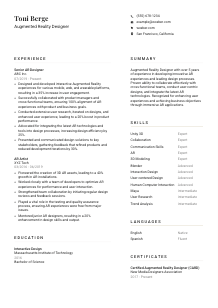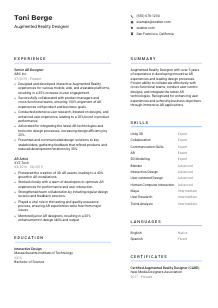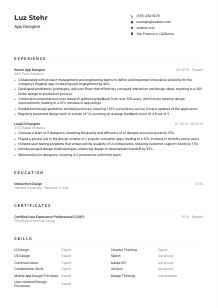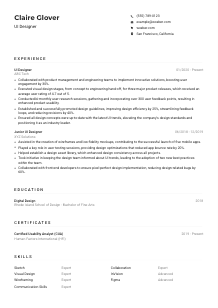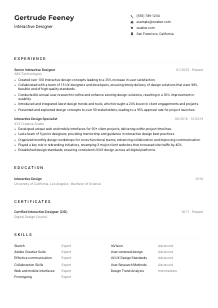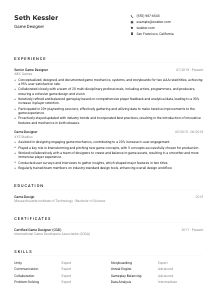Augmented Reality Designer Resume Example
Blending virtual wonders, but your resume looks 'plain reality'? Step into this Augmented Reality Designer resume example, crafted with Wozber free resume builder. Learn how to digitally layer your talents to match job dimensions, creating a career landscape as immersive as your creations!
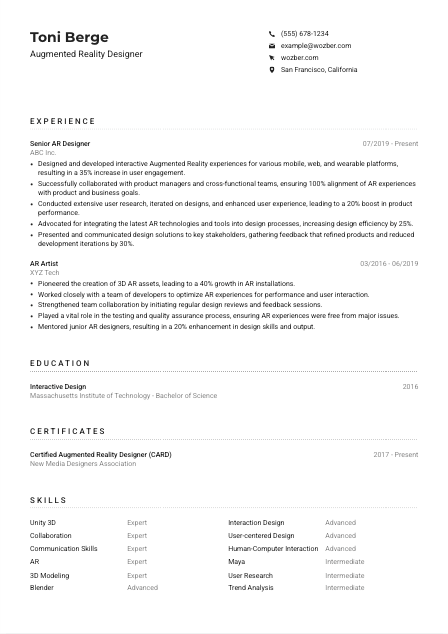
How to write an Augmented Reality Designer Resume?
Embarking on the journey to land your dream Augmented Reality Designer role? You're in the right spot! In the mesmerizing world of Augmented Reality (AR), your resume isn't just a document—it's a portal to your professional prowess. Utilizing Wozber's free resume builder, you'll unlock the secrets to crafting a resume that's as compelling as the AR experiences you create.
This guide, infused with industry-specific insights and tailored strategies, will navigate you through aligning your resume with the unique facets of an Augmented Reality Designer position. Let's turn your career aspirations into your reality!
Personal Details
Your first impression starts here! The Personal Details section is your welcome mat, inviting hiring managers into your professional realm. Dive into how to customize this section, making it resonate with the essence of an Augmented Reality Designer.
1. Brand Yourself with Your Name
Imagine your name in AR—bold and immersive. Transfer that energy onto your resume with a crisp, easily readable font. Your name isn't just a label; it's the initial spark of interest.
2. Design Your Title
"Augmented Reality Designer"—positioning this title beneath your name acts like a virtual handshake, instantly connecting you with your desired role. Think of it as setting the stage for your AR narrative.
3. Connectivity Essentials
In AR, connection is key. Ensure your phone number is typo-free and your email address is professional. Firstname.lastname@email.com personifies simplicity and professionalism, making it easy for potential employers to reach out.
4. Localize Your Strategy
Location matters in AR and job hunting alike. Including "San Francisco, California" not only matches a vital job requirement but also reassures the employer of your readiness—no relocation necessary.
5. Digital Expansion
A professional LinkedIn profile or portfolio website can be like the augmented layer to your resume, offering a deeper dive into your projects and achievements. Ensure it's updated and mirrors the story you're telling on your resume.
Takeaway
Crafting the perfect Personal Details section is like laying the foundation of an AR experience—it sets the tone for what's to come. Aim for precision, relevance, and a hint of your unique professional identity. It's your first step toward making an unforgettable impression.





Experience
Transform your experiences into a captivating storyboard. The Experience section is where your AR design achievements take center stage. Let's model it to reflect the depth of your expertise and your seamless fit for the Augmented Reality Designer role.
- Designed and developed interactive Augmented Reality experiences for various mobile, web, and wearable platforms, resulting in a 35% increase in user engagement.
- Successfully collaborated with product managers and cross‑functional teams, ensuring 100% alignment of AR experiences with product and business goals.
- Conducted extensive user research, iterated on designs, and enhanced user experience, leading to a 20% boost in product performance.
- Advocated for integrating the latest AR technologies and tools into design processes, increasing design efficiency by 25%.
- Presented and communicated design solutions to key stakeholders, gathering feedback that refined products and reduced development iterations by 30%.
- Pioneered the creation of 3D AR assets, leading to a 40% growth in AR installations.
- Worked closely with a team of developers to optimize AR experiences for performance and user interaction.
- Strengthened team collaboration by initiating regular design reviews and feedback sessions.
- Played a vital role in the testing and quality assurance process, ensuring AR experiences were free from major issues.
- Mentored junior AR designers, resulting in a 20% enhancement in design skills and output.
1. Decode and Highlight
Dissect the job posting like an AR project—identify each requirement and match it with your past achievements. Spotlight your roles in designing AR experiences for mobile, web, and wearable platforms, just as you've led projects resulting in a significant uptick in user engagement.
2. Role and Realm
Structure your timeline starting with the most recent. Just like layering in AR design, your latest role should come first, laying the groundwork for your professional narrative. Each role should clearly outline your title, company, and the magic you made there.
3. Achievement Alchemy
Your accomplishments should read like a highlight reel of AR miracles—"Designed interactive AR experiences leading to a 35% increase in user engagement". Quantify your impact to bring dimension to your work, much like the depth you add to AR environments.
4. Relevance is Key
Filter your experiences through the lens of AR design. Every point should resonate with the intricacies of Augmented Reality, bringing forth your hands-on work with Unity 3D, Blender, or Maya, and your seamless collaboration with cross-functional teams.
5. Trim the Excess
Keep your narrative focused. While being the office karaoke star might be fun, save that for the interview icebreakers. Focus on the experiences that align with AR design, pushing your resume towards a clear target—landing that AR Designer role.
Takeaway
Think of your experience section as an AR showcase, demonstrating your ability to transform the user's reality. It's not just about listing jobs; it's about telling a compelling story of your impact and readiness for the Augmented Reality Designer role.
Education
In the realm of Augmented Reality Design, your educational background is the scaffolding that supports your skillset. Let's curate your Education section to underline your qualifications, perfectly aligned with the AR Designer role.
1. Marking the Essentials
Begin with identifying the cornerstone requirement from the job description—a Bachelor's degree in Interaction Design, Interactive Media, Digital Art, or related fields. Your degree is the blueprint, validating your foundational knowledge in AR design.
2. Layout and Structure
Keep this section intuitive and user-friendly. List your degree, field of study, the institution, and your graduation date, much like organizing layers in an AR project for clarity and impact.
3. Detailing the Design
Tailor your degree details to mirror the job's educational requirements directly. If your degree is in a field directly related to AR, such as Interactive Design, it's like having a customized key to unlock your dream role.
4. Course Highpoints
Highlighting relevant courses can provide a sneak peek into your specialized skills, especially if you're early in your career. Though not always necessary, it's like adding Easter eggs in an AR experience—extra points for engagement.
5. Beyond the Basics
If you've achieved honors or spearheaded notable projects in your educational journey, mention these. It shows a proactive and engaged approach, qualities that are invaluable in the constantly evolving field of AR design.
Takeaway
Approach the Education section as you would an AR design project—meticulously crafted to show depth, relevance, and engagement. It's your chance to showcase the solid foundation that your AR design skills are built on.
Certificates
In the fast-paced world of AR design, staying ahead means continuously learning and upskilling. Certificates are your badges of honor, showcasing your commitment and expertise. Let's weave them into your resume to shine a light on your specialized skills.
1. Key Certificates
While the job description didn't specify certification requirements, adding relevant AR design certifications can distinguish you from other candidates. Think of them as power-ups in a game, enhancing your profile.
2. Selective Showcase
Quality over quantity—list certificates that demonstrate your prowess in core AR design skills and technologies. A "Certified Augmented Reality Designer" title, for example, directly signals your specialized expertise.
3. Timely Transparency
If your certificates come with a validity period or reflect recent achievements, include the dates. This shows you're not just keeping pace with the evolving AR landscape but are at the forefront, always learning.
4. Keep It Current
The AR world is ever-changing. Regularly pursuing courses and certifications relevant to your career aspirations doesn't just add to your skill set; it showcases your passion for growth and innovation.
Takeaway
In the dynamic field of AR, continuous learning is key. Highlighting your certifications isn't just about showing what you know—it's about demonstrating your dedication to staying ahead of the curve.
Skills
The Skills section is your professional highlight reel, showcasing the technical prowess and soft skills that make you the perfect fit for an AR Designer role. Let's dive into curating a skillset that resonates with the demands of the role, crafting a compelling narrative of your capabilities.
1. AR Skills Insight
Comb through the job description with a developer's eye—extract both explicitly mentioned skills and infer others based on responsibilities. Knowing Unity 3D, Blender, or Maya isn't just a prerequisite; it's your ticket to showcasing how well-equipped you are for this role.
2. Tailored Talent Showcase
Align your skills with the needs of the job. Highlight your "Expert" level proficiency in Unity 3D, and don't forget to shine a light on your soft skills like collaboration and communication—equally crucial in creating AR wonders.
3. Precise Presentation
Resist the urge to list every skill under the sun. Instead, concentrate on those most relevant to an Augmented Reality Designer. It's about quality, not quantity, making every skill listed a testament to your suitability for the role.
Takeaway
Approach your skills section as a curated exhibition of your technical and interpersonal abilities. Demonstrating your proficiency in the skills that matter most assures hiring managers of your potential to innovate and excel in the AR domain.
Languages
In the global marketplace of Augmented Reality, communication traverses beyond code into the realm of human interaction. The ability to converse in multiple languages can be your edge, making the Languages section more than just an add-on—it's a reflection of your capability to navigate diverse settings.
1. Job Description Linguistic Clues
"Must have the ability to converse fluently in English." This isn't just a requirement; it's a gateway to ensure your creations can communicate across cultures. Highlighting your native or fluent English proficiency sets the stage for global engagement.
2. Essential Languages
Position your English proficiency front and center, followed by any additional languages you're fluent in. Each language you list is a bridge to new experiences, collaborations, and user interactions in the AR landscape.
3. Comprehensive Proficiency
Be transparent about your language levels—whether you're native, fluent, or somewhere in between. This honesty provides insight into how effectively you can operate in multi-linguistic environments.
4. Global Significance
In a role that might expand to international markets, showcasing your multilingual skills could elevate your profile, making you the preferred candidate for projects that span different cultures and geographies.
5. Your Linguistic Scope
Understanding and conversing in multiple languages in the context of AR design can mean more nuanced user experiences and broader reach for your projects. View each language you learn as a step towards a more inclusive and versatile AR future.
Takeaway
Your ability to navigate diverse linguistic landscapes enriches your AR toolkit, offering a unique perspective on global user experiences. Embrace your languages as pivotal elements in your professional journey, connecting you to broader opportunities and deeper understandings.
Summary
The Summary section is your moment to captivate, providing a snapshot that encapsulates your essence as an Augmented Reality Designer. Let's craft a narrative that not only aligns with the job's expectations but also highlights your unique contributions to the AR world.
1. Essence of AR Excellence
Begin by absorbing the essence of the Augmented Reality Designer role. Your summary should reflect a blend of technical skill, creativity, and impact—attributes that define not just your career but your contribution to the AR landscape.
2. Engaging Introduction
Kickstart your summary with a powerful opener that immediately positions you as an AR visionary, weaving in aspects of your proficiency and passion for the field. This is your headline, grabbing attention and inviting readers to dive deeper into your professional world.
3. Addressing AR Achievements
Distill your AR journey into key achievements and skills, making sure every word counts. Mentioning your role in boosting user engagement or your expertise in Unity 3D is like planting flags that mark your territory in the AR domain.
4. Conciseness is Key
An captivating summary is like a teaser trailer for the blockbuster of your career—it piques interest without revealing everything. Craft a concise, intriguing narrative that compels hiring managers to explore your AR saga further.
Takeaway
Your summary is the magic spell that can open doors to interviews and opportunities. Weave it with care, reflecting on your AR journey, and tailor it to sing in harmony with the job you're aiming for. Let it be the beacon that guides your future employer to recognize your potential.
Launching Your Augmented Reality Designer Journey
Congratulations! You've now ventured through the blueprint of crafting a resume tailored for an Augmented Reality Designer position. Remember, Wozber's free resume builder is your ally—offering ATS-compliant resume templates and an ATS resume scanner to ensure your resume is optimized and ready to capture the attention of hiring managers. Your resume is the bridge between your AR skills and your next career milestone.
Polish it, imbue it with your unique essence, and let Wozber guide you to your next big opportunity. The future is augmented, and it awaits your touch. Go forth and create your path!

- Bachelor's degree in Interaction Design, Interactive Media, Digital Art, or a related field.
- Minimum of 3 years of experience in Augmented Reality design.
- Proficiency in 3D modeling and animation software such as Unity 3D, Blender, or Maya.
- Strong understanding of human-computer interaction and user-centered design principles.
- Excellent collaboration and communication skills, with the ability to work closely with cross-functional teams.
- Must have the ability to converse fluently in English.
- Must be located in San Francisco, California.
- Design and develop interactive Augmented Reality experiences for various platforms, including mobile, web, and wearable devices.
- Collaborate with product managers and development teams to ensure AR experiences align with product and business goals.
- Conduct user research and iterate on designs to enhance user experience and product performance.
- Stay updated with the latest AR technologies, tools, and trends, and advocate for their integration into design processes.
- Present and communicate design solutions to stakeholders and gather feedback for further refinement.





